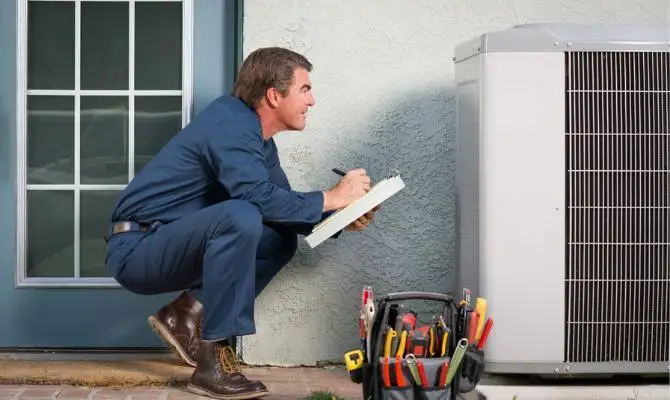As the summer months roll around, air conditioning units become an essential part of keeping homes and offices cool and comfortable. However, like any appliance, air conditioners require regular maintenance to function efficiently. One common issue that homeowners face with their AC units is a clogged drain line. In this article, we will discuss the causes and symptoms of a clogged AC drain line and how to unclog it.
Clearing AC Drain Line
The air conditioner’s drain line is responsible for removing excess water and moisture from the unit. When this line becomes clogged, it can lead to water damage and affect the unit’s performance. Here are the steps to clear an AC drain line:
- Turn off the power to the air conditioning unit: Before you start working on your air conditioning unit, it’s essential to turn off the power to the unit. You can do this by turning off the circuit breaker that powers the unit.
- Locate the AC drain line: The AC drain line is typically located outside the house, near the air conditioning unit. It’s a PVC pipe that extends from the unit and drains water away from the house.
- Inspect the drain line for clogs: Once you’ve located the AC drain line, inspect it for any signs of clogs. You can use a flashlight to look inside the pipe and see if there’s any standing water or debris.
- Use a wet/dry vacuum to remove the clog: If you see a clog in the drain line, you can use a wet/dry vacuum to remove it. Attach the vacuum to the end of the drain line and turn it on. The vacuum will suck out the clog and any standing water in the pipe.
- Flush the drain line with water: After you’ve removed the clog, it’s essential to flush the drain line with water to ensure it’s clear. You can do this by pouring water down the drain line or using a hose to flush it out.
- Turn the power back on: Once you’ve cleared the AC drain line, you can turn the power back on to the air conditioning unit.
Clogged Condensate Drain Line
One of the main reasons for a clogged AC drain line is a buildup of dirt and debris in the condensate drain line. Over time, mold, algae, and other contaminants can grow inside the line, creating a blockage. Another cause of a clogged condensate drain line is a disconnected drain line. This issue can cause water to back up in the unit and lead to water damage.
How to Unclog AC Drain Line
There are several methods to unclog an AC drain line, depending on the severity of the blockage. One way to clear the line is to use a wire brush or a straightened coat hanger to remove any debris inside the drain line. Another method is to use a mixture of white vinegar and water to dissolve any buildup inside the drain line. Simply pour the solution into the drain line and let it sit for about an hour before flushing it out with water.
HVAC Drain Line
The HVAC system’s drain line is an essential component of the air conditioning unit. The drain line removes condensation from the unit and prevents water damage. A clogged HVAC drain line can lead to costly repairs and even pose health risks, such as mold growth. Regular maintenance and cleaning of the HVAC drain line can prevent clogs and ensure the unit runs efficiently.
Unclog AC Drain Line
A clogged AC drain line can cause several problems, such as water damage, reduced cooling performance, and mold growth. If you notice any signs of a clogged drain line, such as water leaking from the unit, musty odors, or reduced airflow, it\’s essential to address the issue promptly. One way to prevent clogs is to schedule regular maintenance and cleaning of the unit.
How to Clean AC Drain Pan
The AC drain pan is located underneath the evaporator coils and collects condensation from the unit. Over time, the drain pan can become clogged with dirt, debris, and mold, leading to a clogged drain line. To clean the AC drain pan, first, turn off the unit and remove the access panel. Then, use a mixture of warm water and mild detergent to clean the pan thoroughly. Rinse the pan with water and replace the access panel.
AC Drain Pipe
The AC drain pipe is a PVC pipe that runs from the air conditioner to the outside of the home or office. This pipe removes excess water and moisture from the unit and prevents water damage. A clogged AC drain pipe can cause water to back up into the unit and lead to costly repairs. Regular maintenance and cleaning of the AC drain pipe can prevent clogs and ensure the unit runs efficiently.
Condensate Drain Line
The condensate drain line is responsible for removing excess water and moisture from the air conditioning unit. Over time, this line can become clogged with mold, algae, and other contaminants, leading to a blockage. A clogged condensate drain line can cause water to back up into the unit, leading to water damage and mold growth. It’s essential to address any signs of a clogged condensate drain line promptly to prevent costly repairs and health risks.
Clogged Condensate Drain Line: Causes
There are several reasons why a condensate drain line can become clogged. Some of the most common causes include:
- Dirt and debris: Dirt and debris can accumulate in the AC drain line over time, leading to a clog. This is particularly common if the air filter is dirty or if the air conditioning unit is located in a dusty environment.
- Mold and algae: Mold and algae can grow inside the AC drain line, leading to a clog. This is particularly common in humid environments or if the air conditioning unit is not used regularly.
- Incorrect installation: If the AC drain line is not installed correctly, it can cause water to back up into the unit, leading to a clog.
Symptoms of a Clogged Condensate Drain Line
There are several symptoms of a clogged condensate drain line. Some of the most common include:
- Water leaks: If the condensate drain line is clogged, water can back up into the air conditioning unit and cause leaks.
- Reduced cooling performance: A clogged condensate drain line can cause reduced cooling performance because the air conditioning unit may shut off to prevent water damage.
- Mold growth: A clogged condensate drain line can lead to mold growth inside the unit, which can spread throughout the house and cause health problems.
- Strange odors: Mold and algae growth inside the AC drain line can cause strange odors to come from the air conditioning unit.
Conclusion
In conclusion, a clogged AC drain line can cause several problems, including water damage, reduced cooling performance, and mold growth. Regular maintenance and cleaning of the air conditioning unit\’s drain line can prevent clogs and ensure the unit runs efficiently. If you notice any signs of a clogged drain line, such as water leaking from the unit, musty odors, or reduced airflow, it’s essential to address the issue promptly. By following the tips outlined in this article, you can unclog your AC drain line and keep your air conditioning unit functioning properly.



